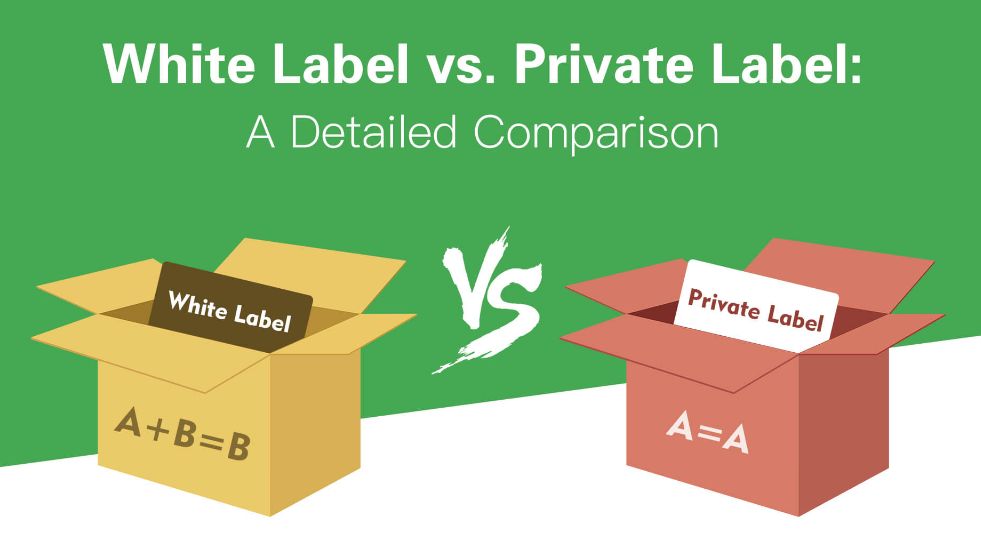Delving into Private Label vs. Custom Design, we explore paths for fitness brand identity. Here, we unravel each strategy's impact, aiming to crystallize the ideal choice for your fitness brand. Navigate the nuances of mass production versus unique creation, each path painting a distinct brand story.

Definition of Private Label Manufacturing
In fitness, Private Label Manufacturing (PLM) signifies rebranding mass-produced items under a retailer's brand. It involves retailers selecting established products and labeling them as their own. This approach, prevalent in fitness gear, allows for rapid market entry.
PLM bypasses the extensive R&D typical in bespoke designs. Fitness retailers are lean on PLM for efficient inventory expansion, offering standard fitness products under their unique branding. It's a strategic move to blend market familiarity with brand-specific aesthetics.
PLM in fitness focuses on cost-effective scalability, prioritizing wide accessibility. This method contrasts with custom design's focus on individuality and specific client needs. In essence, PLM offers fitness businesses a balance of brand presence and production ease.
PL in fitness minimizes expenditure on product development. Brands save on costs linked to manufacturing setup. PL offers efficient resource allocation, crucial in fitness gear production.
This method reduces expenses in material sourcing and design. PL enables fitness brands to optimize spending, elevating profit margins. Reduced overheads in PL lead to competitive pricing strategies.
PL affords rapid market entry for fitness products. It circumvents lengthy product development cycles. Fitness brands leverage PL for swift inventory expansion.
Ready-to-market PL products hasten brand presence. This approach shortens the time from concept to shelf. PL enables immediate response to market demands in fitness.
PL grants fitness brands scalability in production. It allows adjustment to market fluctuations with ease. Brands can expand or reduce offerings without heavy investment.
PL adapts swiftly to changing fitness trends. Scale flexibility in PL aids in managing inventory effectively. This model supports both small-scale and large-scale fitness product rollouts.
Fitness brands retain control over marketing and branding with PL. PL allows customization of branding elements on standard products. Brands shape customer perception through tailored marketing.
Fitness entities maintain brand identity despite using PL products. PL permits creative freedom in packaging and presentation. This control enhances brand loyalty and recognition in the fitness sector.
PL reduces risks associated with product failure. Fitness brands mitigate the financial impact of unsold stock. PL’s tested products lower market entry risks.
This model provides safety in investment for fitness businesses. PL diminishes the risk of inventory obsolescence. Fitness brands leverage PL’s reliability to ensure market stability.
PL facilitates easier entry into diverse fitness markets. It enables brands to tap into existing customer bases. PL aids in overcoming barriers to new market segments.
This approach leverages established product acceptance. Fitness brands use PL to explore new demographics. PL assists in establishing a foothold in competitive fitness arenas.

Custom Design in fitness implies tailoring products to specific user needs. It involves creating unique fitness gear, distinct from mass-produced items.
This approach caters to individual preferences in functionality and aesthetics. Custom fitness products are developed from ground-up, focusing on bespoke features. They integrate client-specific requirements, from material choice to ergonomic design.
Custom design in fitness transcends standard offerings, delivering personalized functionality. It’s a process where innovation meets individual health and fitness goals. Custom fitness items often incorporate advanced technical specifications, meeting precise user demands.
This method enhances user experience through tailor-made fitness solutions. Custom design represents a fusion of user-centric innovation and specialized fitness expertise.
Custom Design (CD) in fitness products brings unique identity, setting brands apart. Each design, a tailored masterpiece, reflects distinct brand ethos.
CD enables creativity, eclipsing common Private Label (PL) offerings. This distinctiveness resonates deeply with niche markets, fostering unique customer connections. Custom-crafted designs not only meet but anticipate evolving fitness trends.
CD in fitness products carves a niche of exclusivity. This exclusivity embodies a brand's unique philosophy, attracting discerning clientele. PL's broader appeal, CD promises uniqueness. Exclusivity in design translates to a bespoke customer experience.
This approach solidifies a brand's standing in the upper echelons of the fitness market.
Opting for CD often results in higher profit margins. These margins reflect the added value of unique designs. CD's pricing strategy leans on exclusivity, surpassing PL's cost-based approach.
Elevated margins underpin a sustainable business model, fostering long-term growth. Investing in CD translates to higher returns per product, enhancing brand value.
CD prioritizes stringent quality control, ensuring premium product standards. This control extends beyond mere aesthetics, encompassing functionality.
Unlike PL, CD offers detailed attention to each product. This meticulous approach results in superior quality, elevating customer satisfaction. Quality becomes a hallmark of the brand, differentiating it in a competitive market.
CD fosters deep customer loyalty through personalized experiences. Tailored designs create a connection, translating to brand loyalty. PL, CD adapts to individual preferences, enhancing user experience. This personalized approach results in repeat customers and brand advocates. Loyalty in the CD realm is often stronger and more enduring.
CD offers clear market differentiation in the fitness sector. This differentiation is not just visual but functional, aligning with specific fitness needs.
Unlike PL, CD provides solutions that stand out in a crowded market. This differentiation is key to capturing niche segments, positioning the brand uniquely. Differentiation through CD is a strategic move in a saturated market.
|
Aspect |
Unique Design |
Brand Exclusivity |
Higher Margins |
Quality Control |
Customer Loyalty |
Market Differentiation |
|
Definition |
Tailored aesthetics |
Niche appeal |
Increased profit |
Superior standards |
Repeat business |
Stand-out positioning |
|
Target Market |
Niche consumers |
Discerning clients |
Premium segment |
Quality-focused |
Brand enthusiasts |
Differentiated segments |
|
Key Feature |
Customization |
Exclusivity |
Premium pricing |
Meticulous checks |
Personal connection |
Unique offerings |
|
Brand Impact |
Distinct identity |
Prestige |
Enhanced profitability |
Consistent quality |
Stronger allegiance |
Distinct market space |
|
Customer Appeal |
Personalization |
Unique offerings |
Value perception |
Reliability |
Emotional bond |
Innovative solutions |
|
Marketing Focus |
Creativity |
Luxury |
Value addition |
Trustworthiness |
Relationship building |
Differentiation strategy |
|
Competitive Edge |
Innovation |
Rarity |
Financial leverage |
Dependability |
Loyalty retention |
Niche capture |
Table on Advantages of Choosing Custom Design for Unique Brand Identity!

Private Label (PL) offers cost savings in bulk production. Custom Design (CD) entails higher costs due to personalization. PL reduces expenses in design and development.
CD's unique specifications incur additional costs. Economies of scale favor PL over CD. Customization in CD demands specialized resources, elevating expenses.
PL accelerates product launch timelines. CD requires extended periods for design and execution. Quick market entry is a hallmark of PL. CD's meticulous design process lengthens time-to-market.
PL's ready-to-sell model ensures prompt availability. Customization in CD necessitates detailed planning, affecting launch speed.
CD allows for stringent quality checks at each stage. PL often relies on standardized quality norms. Custom products undergo rigorous testing for specific standards.
PL's mass production might compromise individual inspection. CD's focused approach enhances product reliability. Quality assurance in PL is often less detailed than in CD.
CD aligns closely with a brand’s unique identity. PL may limit brand differentiation. Custom products reflect a brand’s ethos and values. PL offers limited scope for brand-specific customization.
CD strengthens brand narrative through exclusive designs. Brand alignment in PL is achieved through labeling and packaging.
CD elicits a strong market response for its uniqueness. PL’s standard models might face stiff competition. Custom products often garner customer interest for their exclusivity.
PL relies on established market preferences for acceptance. CD’s tailored approach appeals to niche markets. Market dynamics influence PL’s widespread acceptance.
PL supports large-scale production efficiently. CD is better suited for limited, targeted production runs. PL facilitates consistent output for widespread distribution.
CD focuses on small-batch, high-quality output. High-volume production in PL meets broader market demands. CD's scale is governed by detailed craftsmanship and specialization.
Custom Design (CD) thrives in niche fitness markets, catering to specific needs. It offers tailored solutions for specialized fitness segments. CD resonates with customers seeking unique fitness products. Niche markets benefit from CD’s attention to detail.
Private Label (PL) can struggle to meet niche market intricacies. CD’s ability to customize attracts niche fitness enthusiasts.
PL suits large-scale fitness product distribution. It enables widespread market penetration with standardized products. PL’s efficiency is advantageous for extensive product lines.
Large-scale operations benefit from PL’s uniformity and cost-effectiveness. CD is less viable for large-scale, uniform production. PL’s scalability caters to broad fitness market demands.
Startups may find PL a practical choice due to lower initial investment. PL allows fitness startups to launch quickly with minimal risk. Limited resources make PL attractive for emerging brands.
CD can be challenging for startups due to higher costs. PL provides a foundation for startups to establish market presence.
Established fitness brands may prefer CD for brand distinction. CD supports established brands in offering unique products. For brand differentiation, CD aligns with established brand values.
Larger resources enable established brands to invest in CD. PL may serve as a secondary strategy for established brands seeking market expansion.
CD empowers brands to offer diverse, customized products. It allows for varied fitness solutions catering to different consumer preferences. CD’s adaptability is key in creating diverse offerings.
PL might limit product diversity due to standardized models. CD’s flexibility is ideal for brands aiming for a diverse product portfolio.
In the e-commerce surge, Private Labels (PL) gain from streamlined online integration. Custom Designs (CD) showcases uniqueness digitally, attracting niche markets. PLs capitalize on e-commerce scalability, optimizing cost-per-click (CPC) strategies.
CDs leverage online platforms for bespoke branding. Both models exploit e-commerce analytics for targeted customer engagement. E-commerce's rise necessitates PL and CD adaptation to online consumer behavior.
Heightened consumer knowledge fuels demand for bespoke designs. PLs offer standard solutions, often missing niche preferences. Aware buyers seek custom products, reflecting personal values.
Informed consumers lean towards unique, tailored offerings over generic PLs. This awareness shift nudges brands towards more specialized, custom-oriented strategies.
Technology's integration streamlines custom design processes, reducing costs. Advanced tools make PLs more adaptable, enhancing appeal. Tech advancements bridge gaps between PL efficiency and custom uniqueness. Digitization in design aids faster, cost-effective customization.
Tech’s role is pivotal in balancing PL’s simplicity with custom design's intricacy.
Sustainability focus pushes custom designs with eco-friendly attributes. PLs adapt, incorporating sustainable practices. Eco-consciousness in design becomes a competitive edge.
Custom designs often lead in sustainability innovation. Green materials and processes are now key in both PL and custom strategies. Sustainable design choices are reshaping both PL and custom approaches.
Health trends influence custom designs with wellness features. PLs respond by integrating health-conscious elements. Custom health-centric products rise in popularity.
Wellness focus in design impacts both PL and custom sectors. Customization allows more health-specific features than standard PLs. Health-oriented designs are becoming crucial in product differentiation.
In competitive markets, custom designs offer an edge. PLs face challenges in differentiating within sectors. Unique custom designs counter PL homogeneity.
Competitive pressures drive innovation in both PL and custom offerings. Market rivalry influences a blend of PL efficiency and custom uniqueness. Fierce competition dictates strategic balance in design choices.

Conducting comprehensive market research is pivotal. It uncovers prevailing fitness trends and customer inclinations. Analyzing competitor strategies offers insights into market gaps.
Identifying target demographics guides the choice between PL and CD. Assessing demand patterns is crucial for model selection. Market analysis shapes the decision-making process, influencing model adoption.
Aligning with a brand's long-term vision is essential. If uniqueness is a core value, CD might be preferable. PL suits brands aiming for rapid market expansion.
A brand’s ethos dictates its model choice. Vision alignment ensures consistency in brand messaging. The decision between PL and CD reflects a brand’s strategic direction.
Resource evaluation guides the selection process. PL requires less upfront investment in design and development. CD demands significant resources for customization.
Assessing financial and operational capabilities is key. Resource allocation impacts the feasibility of PL vs. CD. Efficient resource management dictates the chosen business model.
Customer feedback is a valuable decision-making tool. It provides insights into consumer preferences for PL or CD. Listening to customer needs helps in tailoring offerings.
Feedback analysis can reveal the demand for customized solutions. Understanding customer sentiments aids in model selection. Customer responses influence the balance between PL and CD.
Long-term objectives shape model choice. PL might align with goals of market dominance. CD aligns with aspirations of brand prestige and exclusivity.
Strategic planning incorporates long-term vision with model suitability. Future growth plans dictate the preference for PL or CD. Aligning model choice with long-term objectives is crucial for sustained success.
|
Criteria |
Market Analysis |
Brand Vision |
Resource Allocation |
Customer Feedback |
Long-Term Goals |
|
Focus |
Market trends, competitor analysis |
Brand identity, core values |
Budget, manpower, materials |
User experience, product reviews |
Strategic planning, growth targets |
|
Key Terms |
SWOT, market share |
Branding, uniqueness |
ROI, cost-benefit analysis |
NPS, customer satisfaction index |
Vision statement, KPIs |
|
Methodology |
Data analytics, surveys |
Creative brainstorming |
Financial planning, asset management |
Surveys, focus groups |
Roadmapping, forecasting |
|
Outcome |
Competitive positioning |
Brand differentiation |
Optimized use of resources |
Product improvement, customer retention |
Sustainable growth, market leadership |
|
Tools Used |
Market research tools, analytics |
Brand workshops, mood boards |
Accounting software, resource planning |
Feedback platforms, CRM |
Planning software, goal-setting frameworks |
|
Impact on Business |
Identifies opportunities and threats |
Establishes a clear brand direction |
Ensures efficient operation |
Directs product/service improvement |
Guides future business decisions |
Table on How To Choosing the Right Model for Your Fitness Brand!

Private Label (PL) leverages standardized production, optimizing cost-effectiveness. Custom Design (CD) focuses on bespoke elements, enhancing uniqueness.
PL achieves brand unity through uniformity; CD through distinctiveness. Efficient QC in PL contrasts with adaptable protocols in CD. PL's consistency battles CD's innovation in brand identity.
PL targets budget-conscious demographics, offering affordability. CD appeals to exclusivity seekers. PL's strategy hinges on volume, CD's on bespoke value.
PL focuses on mass market appeal, CD on unique attributes. Analytics drive PL's extensive reach, whereas CD relies on tailored client profiling. Both seek resonant market niches.
PL perceived as pragmatic, cost-effective. CD viewed as premium, personalized. PL's appeal lies in affordability; CD's in craftsmanship. PL builds loyalty through pricing, CD through quality.
PL adapts via customer feedback; CD through individual consultations. PL markets for general needs, CD for specialized demands.
PL exhibits flexibility in mass-market strategies. CD pivots around customer-focused tactics. PL uses broad analytics for widespread appeal. CD employs targeted marketing for distinct allure.
PL's campaigns emphasize cost advantage, CD's highlight exclusivity. PL utilizes competitive pricing; CD showcases unique features. Both require dynamic marketing for relevance.

In fitness branding, PL (Private Label) implies predictable cost curves; CD (Custom Design) often involves variable expenditures. Accurate forecasting for PL necessitates bulk procurement analysis. CD's forecasting requires creative resource allocation.
PL's stable supply chain reduces unpredictability. CD thrives on adaptable budgeting, targeting unique client needs. Both require meticulous fiscal oversight for profitability.
PL scalability relies on mass production capabilities. In contrast, CD scalability hinges on flexible production adjustments. PL's growth is often linear, tied to market penetration rates.
CD growth can be exponential, based on design uniqueness. PL targets wide demographic scalability. CD's scalability is often niche-focused. Both strategies necessitate scalability alignment with market demands.
Margin analysis in PL focuses on cost-efficiency maximization. CD margins benefit from higher-priced, bespoke offerings. PL’s economies of scale drive margin stability.
CD's margins are bolstered by exclusivity and customization. Optimizing PL margins involves streamlined operations. Enhancing CD margins requires innovative design and premium pricing. Both strategies demand careful margin management.
In PL, investments are directed towards standardized product lines. CD demands allocation towards unique design development. PL benefits from bulk manufacturing investment.
CD thrives on investing in skilled craftsmanship. PL's investment strategy prioritizes widespread market appeal. CD focuses on specialized market segments. Both require balanced investment approaches for growth.
Our journey through Private Label vs. Custom Design culminates in a clearer vision for fitness brands. Whether embracing the broad appeal of Private Label or the unique allure of Custom Design, the choice molds your brand's identity. For tailored guidance in sculpting your brand's future, visit SANSANSPORTS for more information.
